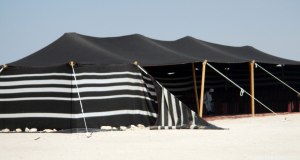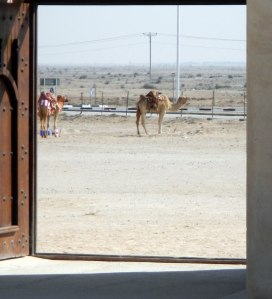“People returned to the town after the attack of 1811, but only very slowly. For many years there were only temporary camps of huts and tents. Eventually a new fortified village grew in the heart of the ruins, but this too came to a dramatic end.” (Al Zubarah Archaeological Site sign)
Situated 105 km (65 miles) from Doha, Qatar’s capital city, within a sun-scorched landscape lies the remains of the ancient, deserted town of Zubarah. At its peak (1760-1811), the pearling town was home to several thousand people and stretched almost a mile along the northern coast. It is Qatar’s largest archaeological site.
Pearl merchants Mohammed bin Khalifa and Ahmed bin Rizq left their native Kuwait in 1179, sailed down the Arabian Gulf along the Saudi border, skirting the small island of Bahrain, and anchored in Qatar where the two established the community. Other families and merchants soon followed. In fact, according to historical documentation, Al Zubarah’s population grew to approximately 6,000 consisting of a mix of local tribes as well as Gulf immigrants.
“With access to the rich pearl beds off the coast of Bahrain and strong tribal links to other merchant families, the town became one of six major trading ports in the region, bringing in great wealth and luxuries from as far away as China and Japan in the east, and Britain in the west,” explains a storyboard at the site.
Located in a climatically unsuitable locale, these were dangerous times. Tribal feuds and disputes between centers of power were common as well as the dangerous seas. Because of the discovery of rich pearl beds and the seas as a major seafaring route for trading ships, piracy and raids on pearling ships, trading vessels and settlements were all too common. It’s no wonder walls were quickly constructed to protect the town.
Standing at the entrance of UNESCO’s newly designated archaeological site, I wonder what it must have been like 200 years ago as I gaze about the sun-scorched landscape. Al Zubarah, like many other small communities, sprang up along the bay and flourished due to lucrative pearl fishing and international trade. Surprisingly, the town’s remains are largely intact with the entire street plan having been preserved for hundreds of years beneath the secluded desert sand.
Today, the desert sands conceal 500 ruined buildings, long walls and towers, two screening walls and the sister settlement of Qal’at Murair, where the town’s fresh water wells were located.
As I begin my short walking tour, strategically placed information boards explain that not only has the way of life of this town’s former inhabitants changed, so too has the architecture of the structures. The tour takes visitors behind the walls of the 18th century town, through a wealthy neighborhood and inside a large fortified building. Popular during Al Zubarah’s era, courtyard houses were low, mosques built of stone, and long but low defensive walls with watch towers encompassing the town.
The 1811 and 1878 Attacks
In 1811, the Sultan of Muscat’s army attacked the town and left it burning; virtually destroying the entire area. Shortly after the attack, the town was rebuilt, although at only one third of its original size; thus, beginning its second life so to speak, defined by a new, inner town wall.
 Archaeology records indicate that people slowly returned and initially lived in palm frond huts, known as barasti, and tents over the ruins of the marketplace (souq). Eventually, the residents rebuilt the town constructing simple, stone-built houses on top of the ruins of the original. It is believed that a new wall and watchtower were built during this time.
Archaeology records indicate that people slowly returned and initially lived in palm frond huts, known as barasti, and tents over the ruins of the marketplace (souq). Eventually, the residents rebuilt the town constructing simple, stone-built houses on top of the ruins of the original. It is believed that a new wall and watchtower were built during this time.
Life remained challenging, particularly as area tribes clamored for more power and authority. Ultimately, in November 1878 members of the Bani Hajir tribe and Sheikh Al Bida’s tribe attacked Al Zubarah, which led to its destruction once and for all.
The local tribes, however, struggled to rebuild and resettle. A number of prevailing factors and events prevented this. The Ottoman Empire claimed the area – although they never physically set up a fort – along with a Bahraini tribe in 1895 that moved to the town. At the time, Bahrain was a British protectorate.
Reportedly, “the move made the British uneasy, and when a large fleet of armed dhows were spotted in the bay, the British took action firing on the assembled ships.” It was further reported that 44 of 200 boats were destroyed with many other vessels seized. The Bahraini Ali bin Ali tribe was ordered to evacuate the settlement within two weeks, which they did.
Al Zubarah was finally abandoned and forgotten, left to crumble under the scorching desert sun and sand.
 Al Zubarah Townsite Today
Al Zubarah Townsite Today
Fused into the stark desert panorama, partially uncovered are a palace, a raised walkway that allowed soldiers to patrol the wall, some homesteads and a mosque, all of which were discovered during excavations in the 1980s.
An L-shaped passageway led to the palace entrance – a main courtyard – which provided privacy. Archaeologists discovered a windowless room believed to be the kitchen that was filled wall to wall with deep, clay-lined cooking pits.
The home of a wealthy family that included nine large courtyards was also discovered. Ornate plaster floors and geometrically decorated wall patterns lend credence to the family’s wealth. Also unearthed in the home were date storerooms, various kitchens with ovens, and plaster lined basins believed to have been primitive bathrooms.
Surrounding the town site in each corner is a round tower that helped support the long walls. According to the storyboard at one of the tower sites, “excavation has revealed internal cross walls for added strength and may have been included to support cannons; a reminder of the dangerous times people lived in.” 
Al Zubarah Fort
Nearby, but outside the town proper, stands the weather-beaten Al Zubarah Fort. Constructed in 1938, the small stone fort with its simple lines and four symmetric corner turrets overlooks a desolate, windswept landscape. Sprinkled nearby are abandoned villages cordoned off for current and future archaeological exploration.
 Zubarah Fort was commissioned by Sheikh Abdullah bin Jassim Al Thani as a Coast Guard station to guard against sea intruders. Transformed into a museum in the 1990s, it recently reopened after a major renovation. A hallmark of the fort is the old cannon located outside the front gate.
Zubarah Fort was commissioned by Sheikh Abdullah bin Jassim Al Thani as a Coast Guard station to guard against sea intruders. Transformed into a museum in the 1990s, it recently reopened after a major renovation. A hallmark of the fort is the old cannon located outside the front gate.
Research indicates that the fort walls were constructed by blending overlapping chunks of limestone with a mortar and pestle mixture specifically designed for grinding mud. The protective compressed mud roof provided shade and coolness for its military occupants.
The fort has three corners each with massive circular towers used for defense, while the fourth rectangular tower was more for aesthetics. The original eight ground floor rooms, typical of early Gulf fortifications, accommodated the solders with a connecting external wood staircase to reach the upper floors and roof. Today the rooms feature artifacts and storyboards as well as a small gift shop.
The Well at Al Zubarah Fort
Fresh water in Qatar was – and continues to be – scarce. For desert dwellers, water is essential for survival. Therefore, men created wells by cutting through the hard limestone until they reached the water table. The water was subsequently stored in underground cisterns. Large water jars were fashioned of clay that held water to be used for everything from drinking and making coffee to watering crops and ensuring that the animals had water to drink.
At the water table level was fresh water, but if dug too deeply, it was salty and would require boiling prior to use. The well that has been discovered in the fort is at least one-half mile deep and could go deeper. Water was drawn up from the well via a bucket that would have been lowered by a long rope. There are other nearby wells outside of the fort, however they are salt water wells and its water unsafe to drink.
The daylong excursion to Qatar’s northwestern portion of the country was interesting and time well spent. Although self-guided, it was interesting to explore and imagine what life was like for these villagers during its years of turbulence. I suspect learning more about the local tribes and their disagreements would make for a fascinating study, thus, providing a more meaningful framework for the archaeological ruins lying before me.
In the meantime, as close as I can come to relating to what life was like in this archaeological site at the moment is atop a camel. Gazing about as my old camel saunters around the fort, I am trying hard to imagine the hardship of life back in the days when  nothing could or would be taken for granted.
nothing could or would be taken for granted.
